Effectiveness of the Criminal Justice Process: A Stakeholder Analysis
VerifiedAdded on 2023/01/12
|10
|2475
|52
Report
AI Summary
This report provides a comprehensive analysis of the criminal justice process, delving into its various stages, including reporting a crime, police investigation, court proceedings, trial, and sentencing. It examines the roles and responsibilities of different stakeholders within the system, such as the police department and the courts, highlighting their contributions to maintaining law and order. The report explores methods used to measure the effectiveness of the criminal justice process, such as amendments, judgments, and imprisonment rates. Furthermore, it evaluates stakeholder effectiveness in reducing reoffending through case studies, such as Ron v Smith. The report concludes by emphasizing the importance of a well-structured legal system in resolving disagreements and controlling crime rates, underscoring the vital role of stakeholders in achieving these objectives.
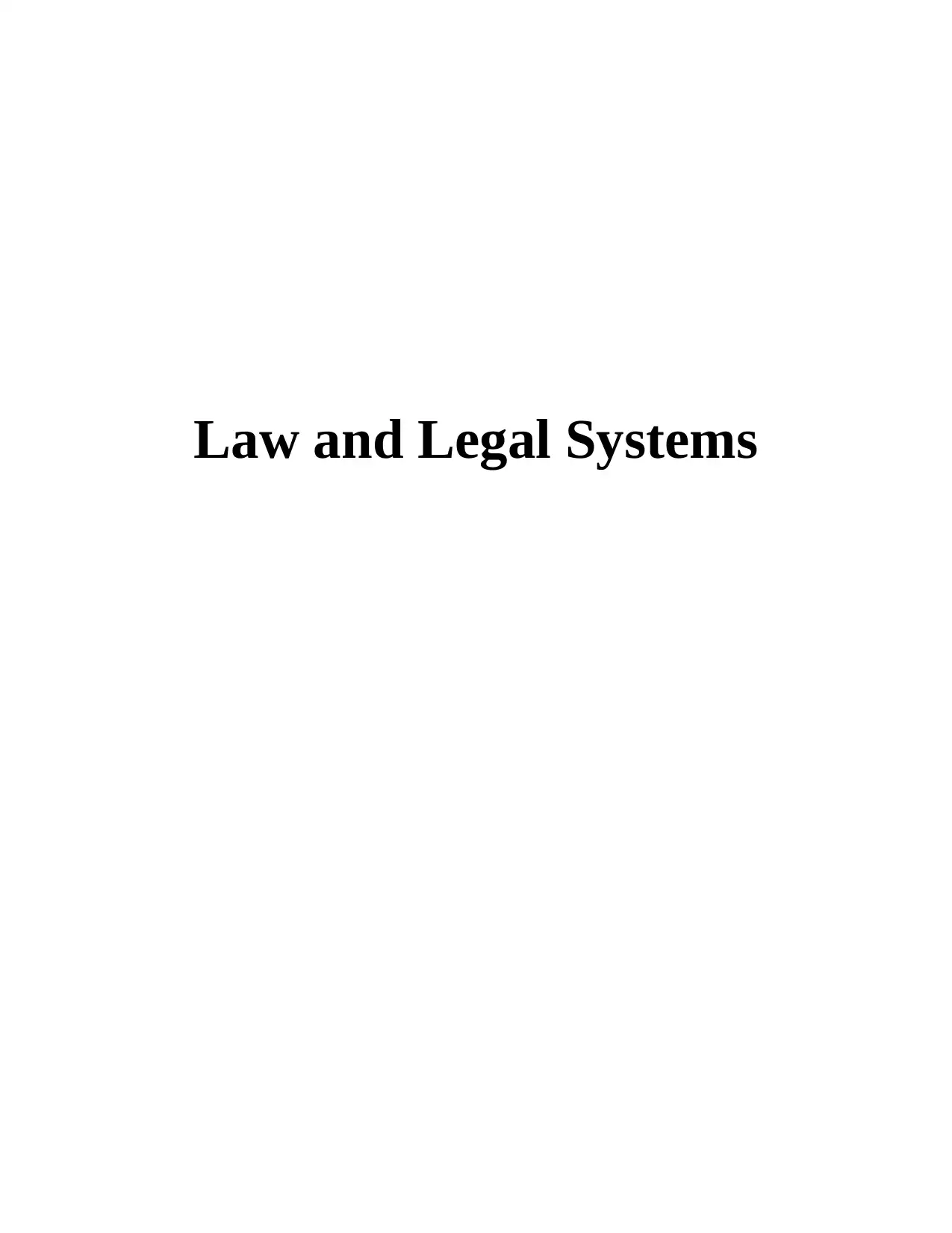
Law and Legal Systems
Paraphrase This Document
Need a fresh take? Get an instant paraphrase of this document with our AI Paraphraser
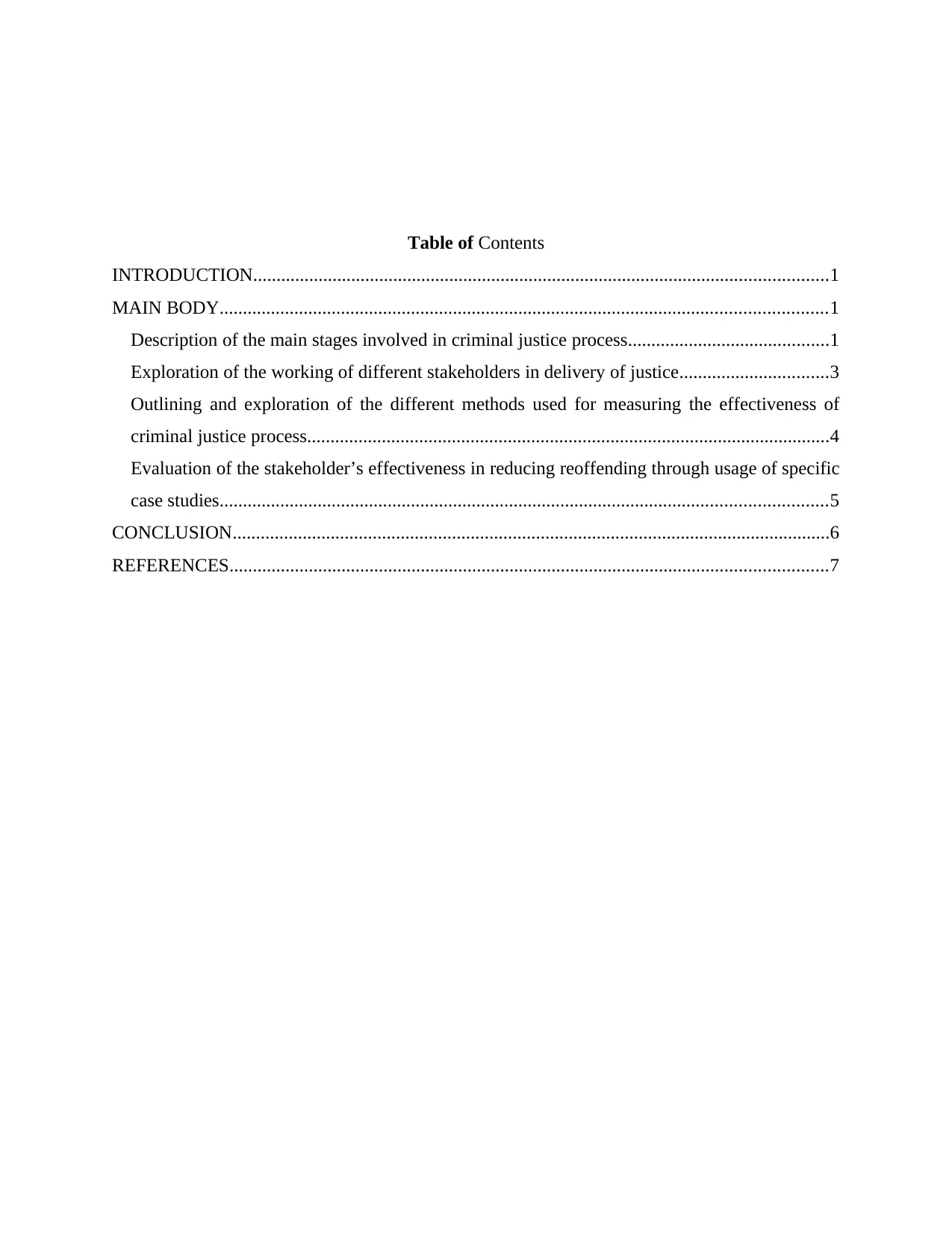
Table of Contents
INTRODUCTION...........................................................................................................................1
MAIN BODY..................................................................................................................................1
Description of the main stages involved in criminal justice process...........................................1
Exploration of the working of different stakeholders in delivery of justice................................3
Outlining and exploration of the different methods used for measuring the effectiveness of
criminal justice process................................................................................................................4
Evaluation of the stakeholder’s effectiveness in reducing reoffending through usage of specific
case studies..................................................................................................................................5
CONCLUSION................................................................................................................................6
REFERENCES................................................................................................................................7
INTRODUCTION...........................................................................................................................1
MAIN BODY..................................................................................................................................1
Description of the main stages involved in criminal justice process...........................................1
Exploration of the working of different stakeholders in delivery of justice................................3
Outlining and exploration of the different methods used for measuring the effectiveness of
criminal justice process................................................................................................................4
Evaluation of the stakeholder’s effectiveness in reducing reoffending through usage of specific
case studies..................................................................................................................................5
CONCLUSION................................................................................................................................6
REFERENCES................................................................................................................................7

⊘ This is a preview!⊘
Do you want full access?
Subscribe today to unlock all pages.

Trusted by 1+ million students worldwide
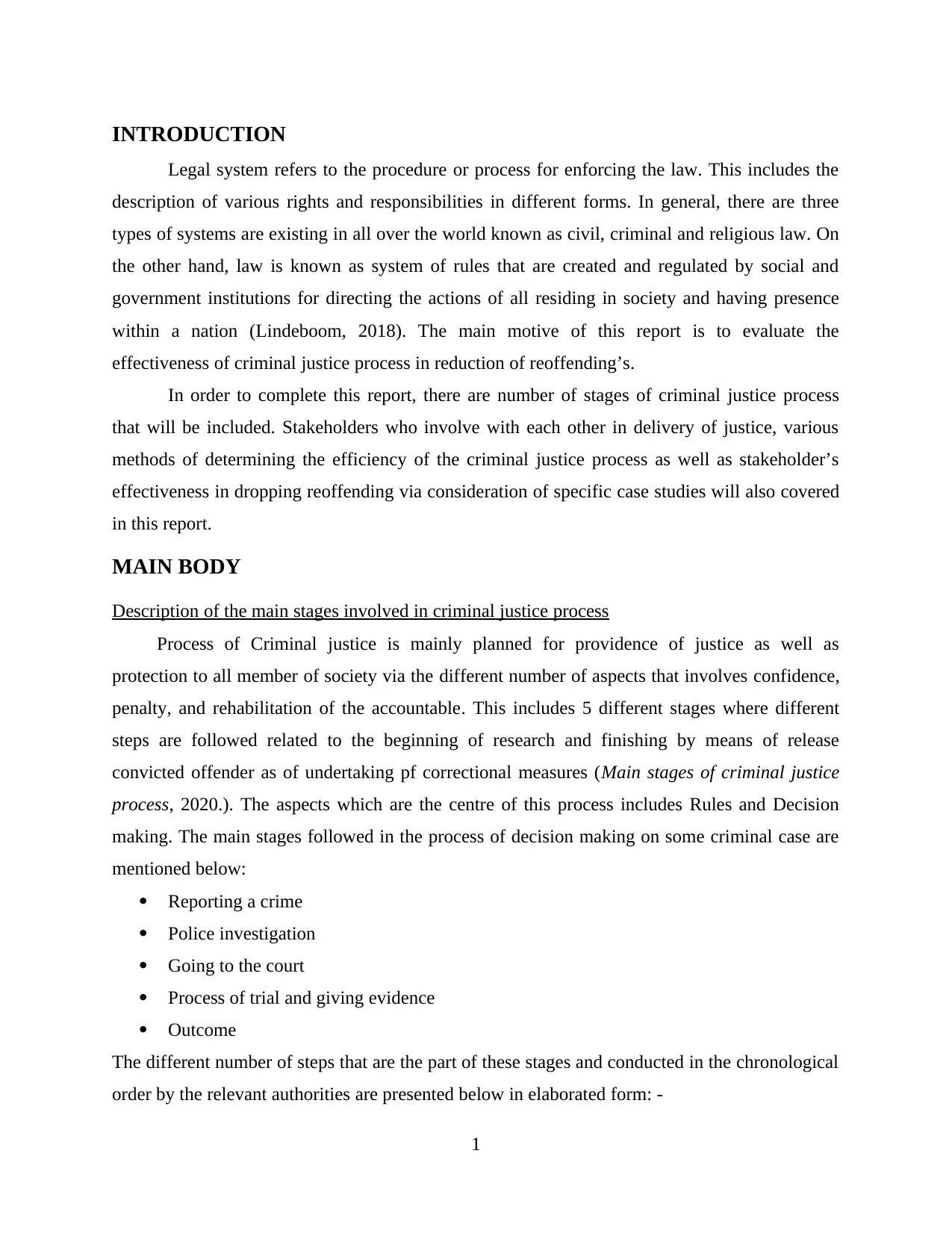
INTRODUCTION
Legal system refers to the procedure or process for enforcing the law. This includes the
description of various rights and responsibilities in different forms. In general, there are three
types of systems are existing in all over the world known as civil, criminal and religious law. On
the other hand, law is known as system of rules that are created and regulated by social and
government institutions for directing the actions of all residing in society and having presence
within a nation (Lindeboom, 2018). The main motive of this report is to evaluate the
effectiveness of criminal justice process in reduction of reoffending’s.
In order to complete this report, there are number of stages of criminal justice process
that will be included. Stakeholders who involve with each other in delivery of justice, various
methods of determining the efficiency of the criminal justice process as well as stakeholder’s
effectiveness in dropping reoffending via consideration of specific case studies will also covered
in this report.
MAIN BODY
Description of the main stages involved in criminal justice process
Process of Criminal justice is mainly planned for providence of justice as well as
protection to all member of society via the different number of aspects that involves confidence,
penalty, and rehabilitation of the accountable. This includes 5 different stages where different
steps are followed related to the beginning of research and finishing by means of release
convicted offender as of undertaking pf correctional measures (Main stages of criminal justice
process, 2020.). The aspects which are the centre of this process includes Rules and Decision
making. The main stages followed in the process of decision making on some criminal case are
mentioned below:
Reporting a crime
Police investigation
Going to the court
Process of trial and giving evidence
Outcome
The different number of steps that are the part of these stages and conducted in the chronological
order by the relevant authorities are presented below in elaborated form: -
1
Legal system refers to the procedure or process for enforcing the law. This includes the
description of various rights and responsibilities in different forms. In general, there are three
types of systems are existing in all over the world known as civil, criminal and religious law. On
the other hand, law is known as system of rules that are created and regulated by social and
government institutions for directing the actions of all residing in society and having presence
within a nation (Lindeboom, 2018). The main motive of this report is to evaluate the
effectiveness of criminal justice process in reduction of reoffending’s.
In order to complete this report, there are number of stages of criminal justice process
that will be included. Stakeholders who involve with each other in delivery of justice, various
methods of determining the efficiency of the criminal justice process as well as stakeholder’s
effectiveness in dropping reoffending via consideration of specific case studies will also covered
in this report.
MAIN BODY
Description of the main stages involved in criminal justice process
Process of Criminal justice is mainly planned for providence of justice as well as
protection to all member of society via the different number of aspects that involves confidence,
penalty, and rehabilitation of the accountable. This includes 5 different stages where different
steps are followed related to the beginning of research and finishing by means of release
convicted offender as of undertaking pf correctional measures (Main stages of criminal justice
process, 2020.). The aspects which are the centre of this process includes Rules and Decision
making. The main stages followed in the process of decision making on some criminal case are
mentioned below:
Reporting a crime
Police investigation
Going to the court
Process of trial and giving evidence
Outcome
The different number of steps that are the part of these stages and conducted in the chronological
order by the relevant authorities are presented below in elaborated form: -
1
Paraphrase This Document
Need a fresh take? Get an instant paraphrase of this document with our AI Paraphraser
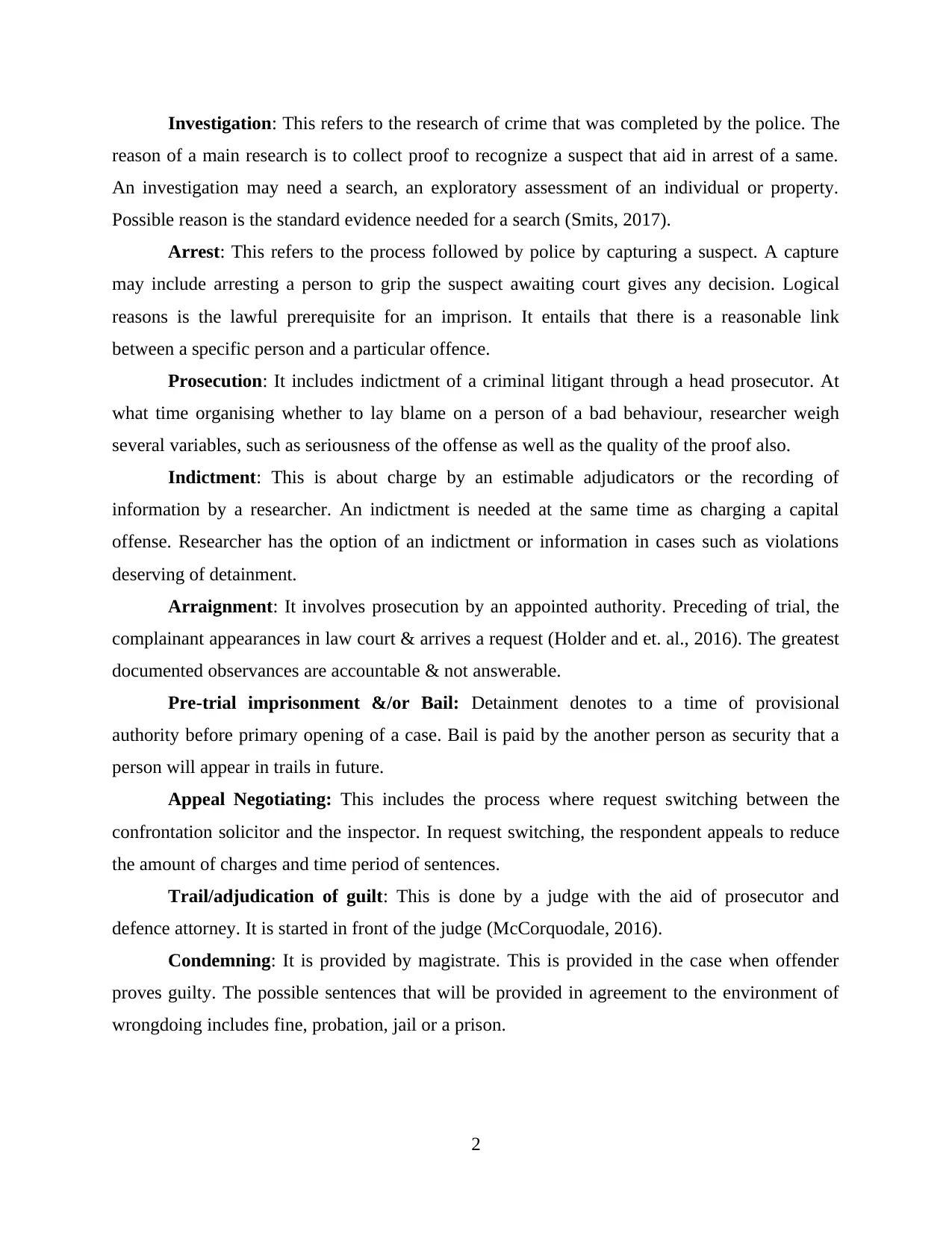
Investigation: This refers to the research of crime that was completed by the police. The
reason of a main research is to collect proof to recognize a suspect that aid in arrest of a same.
An investigation may need a search, an exploratory assessment of an individual or property.
Possible reason is the standard evidence needed for a search (Smits, 2017).
Arrest: This refers to the process followed by police by capturing a suspect. A capture
may include arresting a person to grip the suspect awaiting court gives any decision. Logical
reasons is the lawful prerequisite for an imprison. It entails that there is a reasonable link
between a specific person and a particular offence.
Prosecution: It includes indictment of a criminal litigant through a head prosecutor. At
what time organising whether to lay blame on a person of a bad behaviour, researcher weigh
several variables, such as seriousness of the offense as well as the quality of the proof also.
Indictment: This is about charge by an estimable adjudicators or the recording of
information by a researcher. An indictment is needed at the same time as charging a capital
offense. Researcher has the option of an indictment or information in cases such as violations
deserving of detainment.
Arraignment: It involves prosecution by an appointed authority. Preceding of trial, the
complainant appearances in law court & arrives a request (Holder and et. al., 2016). The greatest
documented observances are accountable & not answerable.
Pre-trial imprisonment &/or Bail: Detainment denotes to a time of provisional
authority before primary opening of a case. Bail is paid by the another person as security that a
person will appear in trails in future.
Appeal Negotiating: This includes the process where request switching between the
confrontation solicitor and the inspector. In request switching, the respondent appeals to reduce
the amount of charges and time period of sentences.
Trail/adjudication of guilt: This is done by a judge with the aid of prosecutor and
defence attorney. It is started in front of the judge (McCorquodale, 2016).
Condemning: It is provided by magistrate. This is provided in the case when offender
proves guilty. The possible sentences that will be provided in agreement to the environment of
wrongdoing includes fine, probation, jail or a prison.
2
reason of a main research is to collect proof to recognize a suspect that aid in arrest of a same.
An investigation may need a search, an exploratory assessment of an individual or property.
Possible reason is the standard evidence needed for a search (Smits, 2017).
Arrest: This refers to the process followed by police by capturing a suspect. A capture
may include arresting a person to grip the suspect awaiting court gives any decision. Logical
reasons is the lawful prerequisite for an imprison. It entails that there is a reasonable link
between a specific person and a particular offence.
Prosecution: It includes indictment of a criminal litigant through a head prosecutor. At
what time organising whether to lay blame on a person of a bad behaviour, researcher weigh
several variables, such as seriousness of the offense as well as the quality of the proof also.
Indictment: This is about charge by an estimable adjudicators or the recording of
information by a researcher. An indictment is needed at the same time as charging a capital
offense. Researcher has the option of an indictment or information in cases such as violations
deserving of detainment.
Arraignment: It involves prosecution by an appointed authority. Preceding of trial, the
complainant appearances in law court & arrives a request (Holder and et. al., 2016). The greatest
documented observances are accountable & not answerable.
Pre-trial imprisonment &/or Bail: Detainment denotes to a time of provisional
authority before primary opening of a case. Bail is paid by the another person as security that a
person will appear in trails in future.
Appeal Negotiating: This includes the process where request switching between the
confrontation solicitor and the inspector. In request switching, the respondent appeals to reduce
the amount of charges and time period of sentences.
Trail/adjudication of guilt: This is done by a judge with the aid of prosecutor and
defence attorney. It is started in front of the judge (McCorquodale, 2016).
Condemning: It is provided by magistrate. This is provided in the case when offender
proves guilty. The possible sentences that will be provided in agreement to the environment of
wrongdoing includes fine, probation, jail or a prison.
2
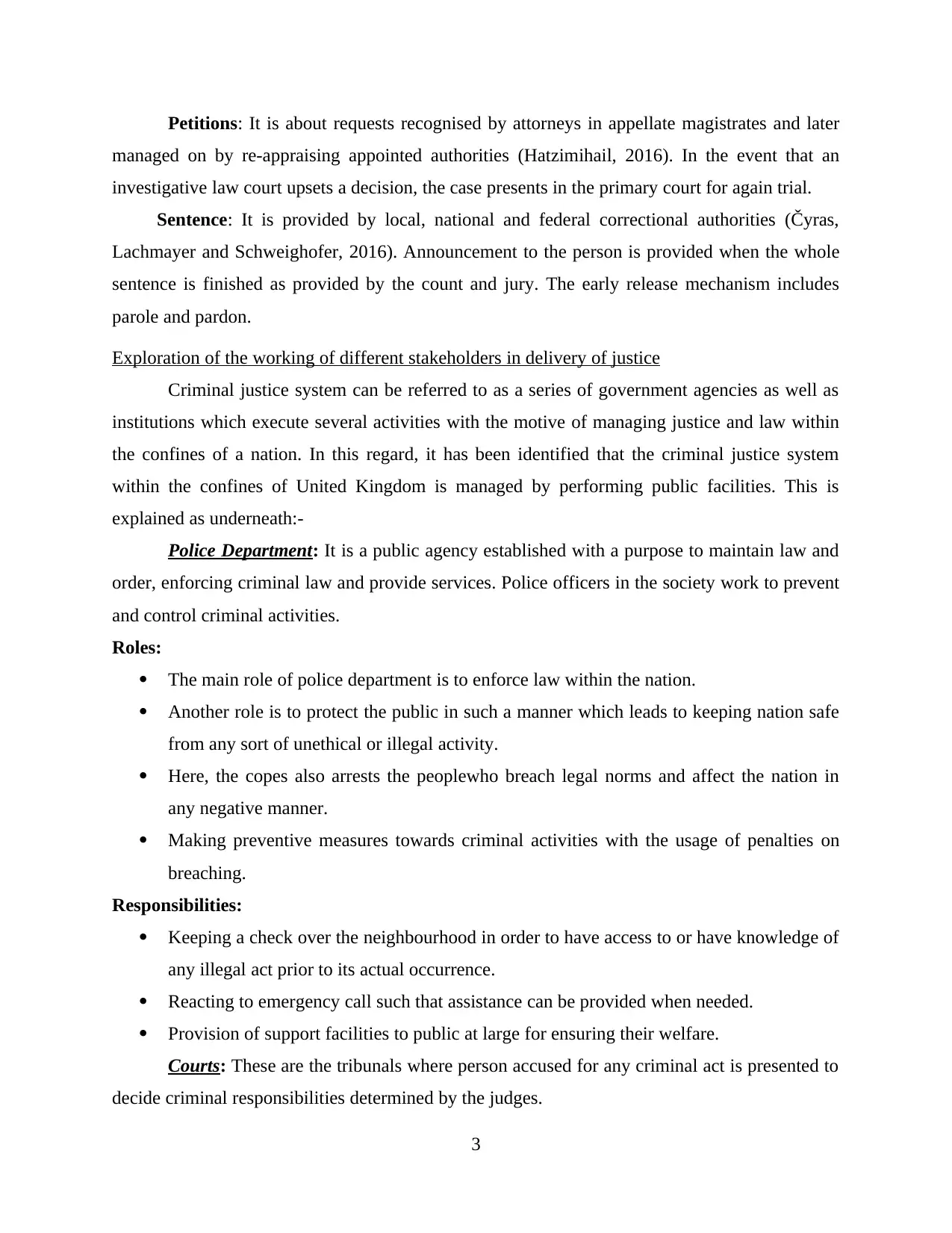
Petitions: It is about requests recognised by attorneys in appellate magistrates and later
managed on by re-appraising appointed authorities (Hatzimihail, 2016). In the event that an
investigative law court upsets a decision, the case presents in the primary court for again trial.
Sentence: It is provided by local, national and federal correctional authorities (Čyras,
Lachmayer and Schweighofer, 2016). Announcement to the person is provided when the whole
sentence is finished as provided by the count and jury. The early release mechanism includes
parole and pardon.
Exploration of the working of different stakeholders in delivery of justice
Criminal justice system can be referred to as a series of government agencies as well as
institutions which execute several activities with the motive of managing justice and law within
the confines of a nation. In this regard, it has been identified that the criminal justice system
within the confines of United Kingdom is managed by performing public facilities. This is
explained as underneath:-
Police Department: It is a public agency established with a purpose to maintain law and
order, enforcing criminal law and provide services. Police officers in the society work to prevent
and control criminal activities.
Roles:
The main role of police department is to enforce law within the nation.
Another role is to protect the public in such a manner which leads to keeping nation safe
from any sort of unethical or illegal activity.
Here, the copes also arrests the peoplewho breach legal norms and affect the nation in
any negative manner.
Making preventive measures towards criminal activities with the usage of penalties on
breaching.
Responsibilities:
Keeping a check over the neighbourhood in order to have access to or have knowledge of
any illegal act prior to its actual occurrence.
Reacting to emergency call such that assistance can be provided when needed.
Provision of support facilities to public at large for ensuring their welfare.
Courts: These are the tribunals where person accused for any criminal act is presented to
decide criminal responsibilities determined by the judges.
3
managed on by re-appraising appointed authorities (Hatzimihail, 2016). In the event that an
investigative law court upsets a decision, the case presents in the primary court for again trial.
Sentence: It is provided by local, national and federal correctional authorities (Čyras,
Lachmayer and Schweighofer, 2016). Announcement to the person is provided when the whole
sentence is finished as provided by the count and jury. The early release mechanism includes
parole and pardon.
Exploration of the working of different stakeholders in delivery of justice
Criminal justice system can be referred to as a series of government agencies as well as
institutions which execute several activities with the motive of managing justice and law within
the confines of a nation. In this regard, it has been identified that the criminal justice system
within the confines of United Kingdom is managed by performing public facilities. This is
explained as underneath:-
Police Department: It is a public agency established with a purpose to maintain law and
order, enforcing criminal law and provide services. Police officers in the society work to prevent
and control criminal activities.
Roles:
The main role of police department is to enforce law within the nation.
Another role is to protect the public in such a manner which leads to keeping nation safe
from any sort of unethical or illegal activity.
Here, the copes also arrests the peoplewho breach legal norms and affect the nation in
any negative manner.
Making preventive measures towards criminal activities with the usage of penalties on
breaching.
Responsibilities:
Keeping a check over the neighbourhood in order to have access to or have knowledge of
any illegal act prior to its actual occurrence.
Reacting to emergency call such that assistance can be provided when needed.
Provision of support facilities to public at large for ensuring their welfare.
Courts: These are the tribunals where person accused for any criminal act is presented to
decide criminal responsibilities determined by the judges.
3
⊘ This is a preview!⊘
Do you want full access?
Subscribe today to unlock all pages.

Trusted by 1+ million students worldwide
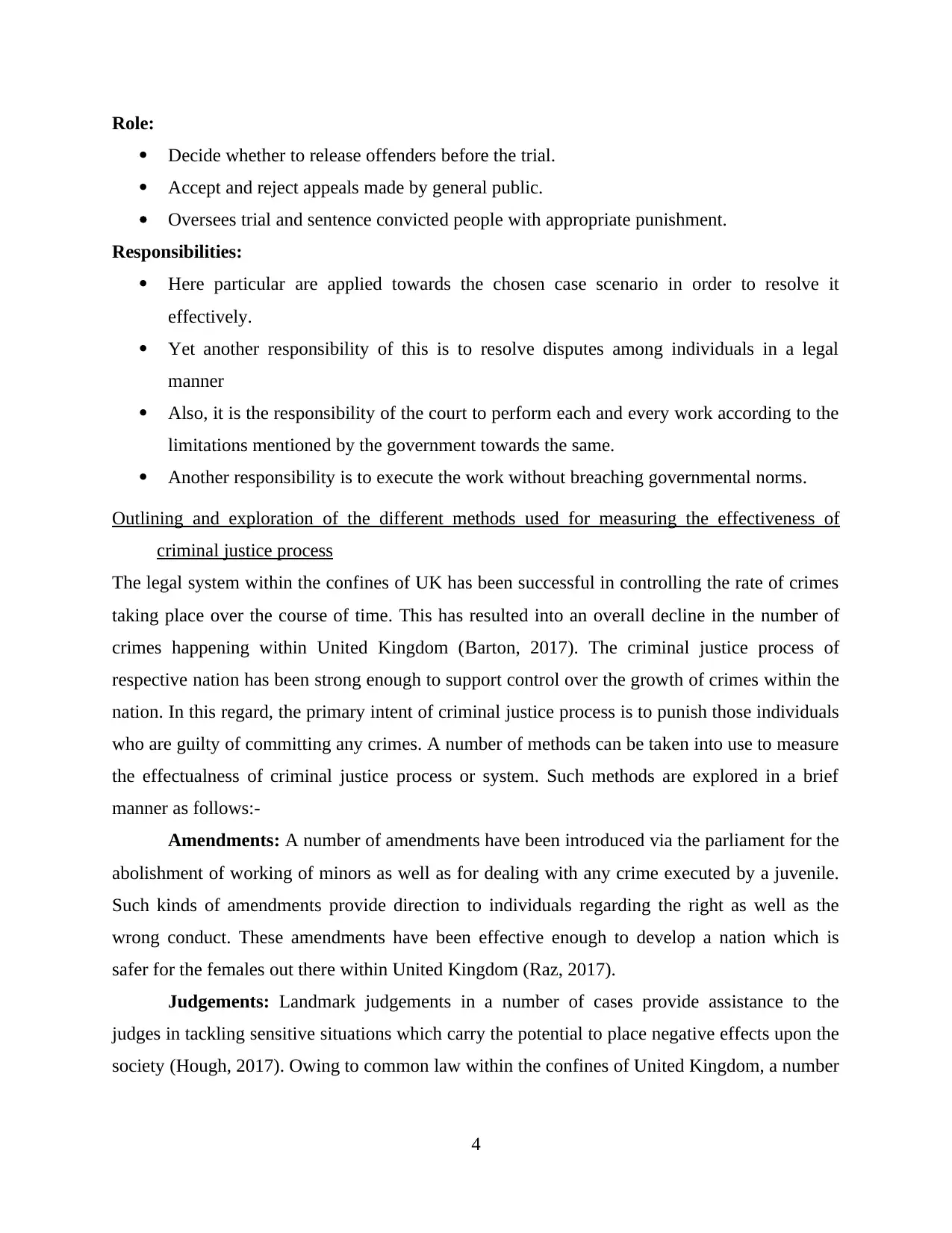
Role:
Decide whether to release offenders before the trial.
Accept and reject appeals made by general public.
Oversees trial and sentence convicted people with appropriate punishment.
Responsibilities:
Here particular are applied towards the chosen case scenario in order to resolve it
effectively.
Yet another responsibility of this is to resolve disputes among individuals in a legal
manner
Also, it is the responsibility of the court to perform each and every work according to the
limitations mentioned by the government towards the same.
Another responsibility is to execute the work without breaching governmental norms.
Outlining and exploration of the different methods used for measuring the effectiveness of
criminal justice process
The legal system within the confines of UK has been successful in controlling the rate of crimes
taking place over the course of time. This has resulted into an overall decline in the number of
crimes happening within United Kingdom (Barton, 2017). The criminal justice process of
respective nation has been strong enough to support control over the growth of crimes within the
nation. In this regard, the primary intent of criminal justice process is to punish those individuals
who are guilty of committing any crimes. A number of methods can be taken into use to measure
the effectualness of criminal justice process or system. Such methods are explored in a brief
manner as follows:-
Amendments: A number of amendments have been introduced via the parliament for the
abolishment of working of minors as well as for dealing with any crime executed by a juvenile.
Such kinds of amendments provide direction to individuals regarding the right as well as the
wrong conduct. These amendments have been effective enough to develop a nation which is
safer for the females out there within United Kingdom (Raz, 2017).
Judgements: Landmark judgements in a number of cases provide assistance to the
judges in tackling sensitive situations which carry the potential to place negative effects upon the
society (Hough, 2017). Owing to common law within the confines of United Kingdom, a number
4
Decide whether to release offenders before the trial.
Accept and reject appeals made by general public.
Oversees trial and sentence convicted people with appropriate punishment.
Responsibilities:
Here particular are applied towards the chosen case scenario in order to resolve it
effectively.
Yet another responsibility of this is to resolve disputes among individuals in a legal
manner
Also, it is the responsibility of the court to perform each and every work according to the
limitations mentioned by the government towards the same.
Another responsibility is to execute the work without breaching governmental norms.
Outlining and exploration of the different methods used for measuring the effectiveness of
criminal justice process
The legal system within the confines of UK has been successful in controlling the rate of crimes
taking place over the course of time. This has resulted into an overall decline in the number of
crimes happening within United Kingdom (Barton, 2017). The criminal justice process of
respective nation has been strong enough to support control over the growth of crimes within the
nation. In this regard, the primary intent of criminal justice process is to punish those individuals
who are guilty of committing any crimes. A number of methods can be taken into use to measure
the effectualness of criminal justice process or system. Such methods are explored in a brief
manner as follows:-
Amendments: A number of amendments have been introduced via the parliament for the
abolishment of working of minors as well as for dealing with any crime executed by a juvenile.
Such kinds of amendments provide direction to individuals regarding the right as well as the
wrong conduct. These amendments have been effective enough to develop a nation which is
safer for the females out there within United Kingdom (Raz, 2017).
Judgements: Landmark judgements in a number of cases provide assistance to the
judges in tackling sensitive situations which carry the potential to place negative effects upon the
society (Hough, 2017). Owing to common law within the confines of United Kingdom, a number
4
Paraphrase This Document
Need a fresh take? Get an instant paraphrase of this document with our AI Paraphraser
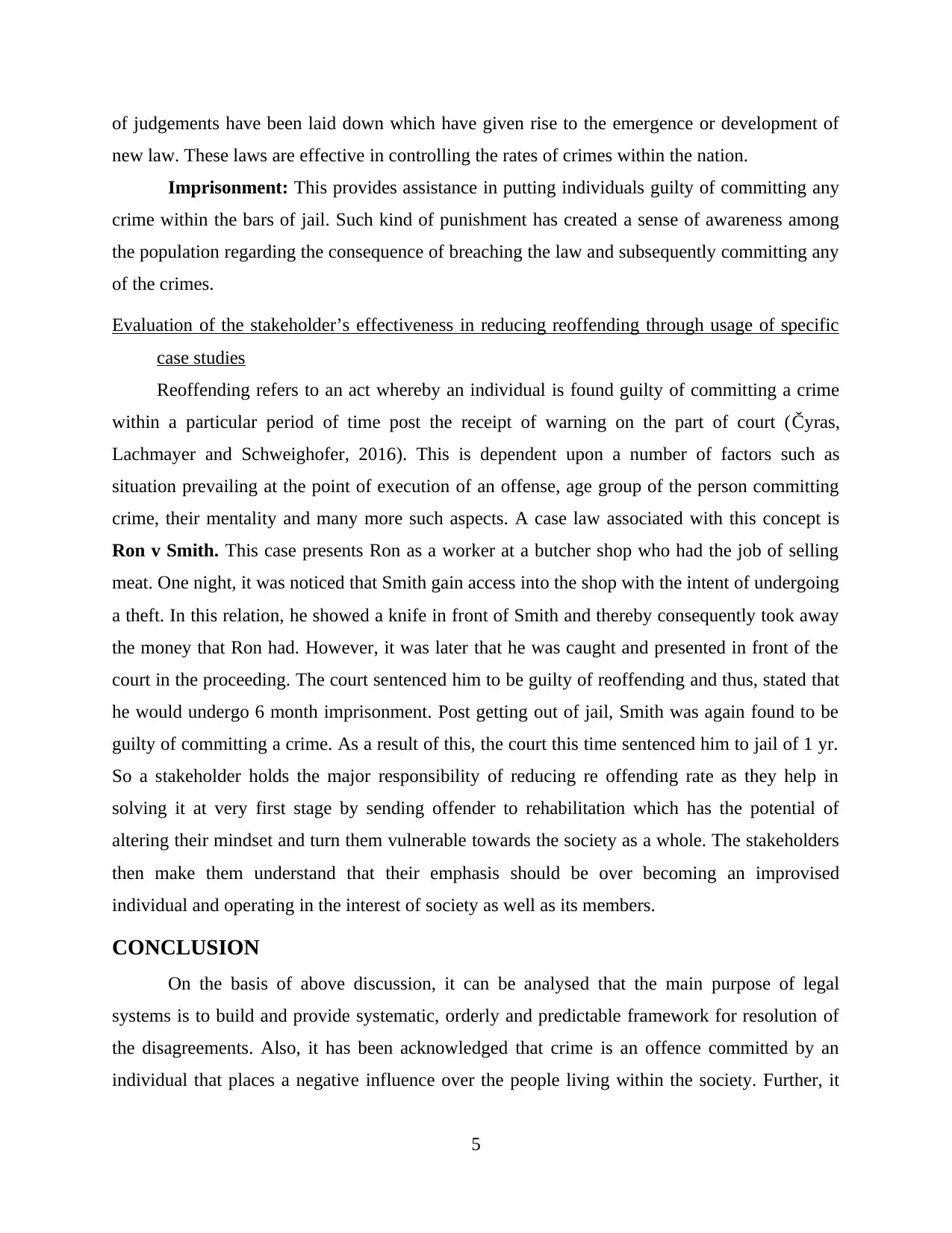
of judgements have been laid down which have given rise to the emergence or development of
new law. These laws are effective in controlling the rates of crimes within the nation.
Imprisonment: This provides assistance in putting individuals guilty of committing any
crime within the bars of jail. Such kind of punishment has created a sense of awareness among
the population regarding the consequence of breaching the law and subsequently committing any
of the crimes.
Evaluation of the stakeholder’s effectiveness in reducing reoffending through usage of specific
case studies
Reoffending refers to an act whereby an individual is found guilty of committing a crime
within a particular period of time post the receipt of warning on the part of court (Čyras,
Lachmayer and Schweighofer, 2016). This is dependent upon a number of factors such as
situation prevailing at the point of execution of an offense, age group of the person committing
crime, their mentality and many more such aspects. A case law associated with this concept is
Ron v Smith. This case presents Ron as a worker at a butcher shop who had the job of selling
meat. One night, it was noticed that Smith gain access into the shop with the intent of undergoing
a theft. In this relation, he showed a knife in front of Smith and thereby consequently took away
the money that Ron had. However, it was later that he was caught and presented in front of the
court in the proceeding. The court sentenced him to be guilty of reoffending and thus, stated that
he would undergo 6 month imprisonment. Post getting out of jail, Smith was again found to be
guilty of committing a crime. As a result of this, the court this time sentenced him to jail of 1 yr.
So a stakeholder holds the major responsibility of reducing re offending rate as they help in
solving it at very first stage by sending offender to rehabilitation which has the potential of
altering their mindset and turn them vulnerable towards the society as a whole. The stakeholders
then make them understand that their emphasis should be over becoming an improvised
individual and operating in the interest of society as well as its members.
CONCLUSION
On the basis of above discussion, it can be analysed that the main purpose of legal
systems is to build and provide systematic, orderly and predictable framework for resolution of
the disagreements. Also, it has been acknowledged that crime is an offence committed by an
individual that places a negative influence over the people living within the society. Further, it
5
new law. These laws are effective in controlling the rates of crimes within the nation.
Imprisonment: This provides assistance in putting individuals guilty of committing any
crime within the bars of jail. Such kind of punishment has created a sense of awareness among
the population regarding the consequence of breaching the law and subsequently committing any
of the crimes.
Evaluation of the stakeholder’s effectiveness in reducing reoffending through usage of specific
case studies
Reoffending refers to an act whereby an individual is found guilty of committing a crime
within a particular period of time post the receipt of warning on the part of court (Čyras,
Lachmayer and Schweighofer, 2016). This is dependent upon a number of factors such as
situation prevailing at the point of execution of an offense, age group of the person committing
crime, their mentality and many more such aspects. A case law associated with this concept is
Ron v Smith. This case presents Ron as a worker at a butcher shop who had the job of selling
meat. One night, it was noticed that Smith gain access into the shop with the intent of undergoing
a theft. In this relation, he showed a knife in front of Smith and thereby consequently took away
the money that Ron had. However, it was later that he was caught and presented in front of the
court in the proceeding. The court sentenced him to be guilty of reoffending and thus, stated that
he would undergo 6 month imprisonment. Post getting out of jail, Smith was again found to be
guilty of committing a crime. As a result of this, the court this time sentenced him to jail of 1 yr.
So a stakeholder holds the major responsibility of reducing re offending rate as they help in
solving it at very first stage by sending offender to rehabilitation which has the potential of
altering their mindset and turn them vulnerable towards the society as a whole. The stakeholders
then make them understand that their emphasis should be over becoming an improvised
individual and operating in the interest of society as well as its members.
CONCLUSION
On the basis of above discussion, it can be analysed that the main purpose of legal
systems is to build and provide systematic, orderly and predictable framework for resolution of
the disagreements. Also, it has been acknowledged that crime is an offence committed by an
individual that places a negative influence over the people living within the society. Further, it
5

has been determined that the stakeholders of criminal justice process play a vital role in
controlling the crime rates and reducing the number of crimes consequently.
6
controlling the crime rates and reducing the number of crimes consequently.
6
⊘ This is a preview!⊘
Do you want full access?
Subscribe today to unlock all pages.

Trusted by 1+ million students worldwide
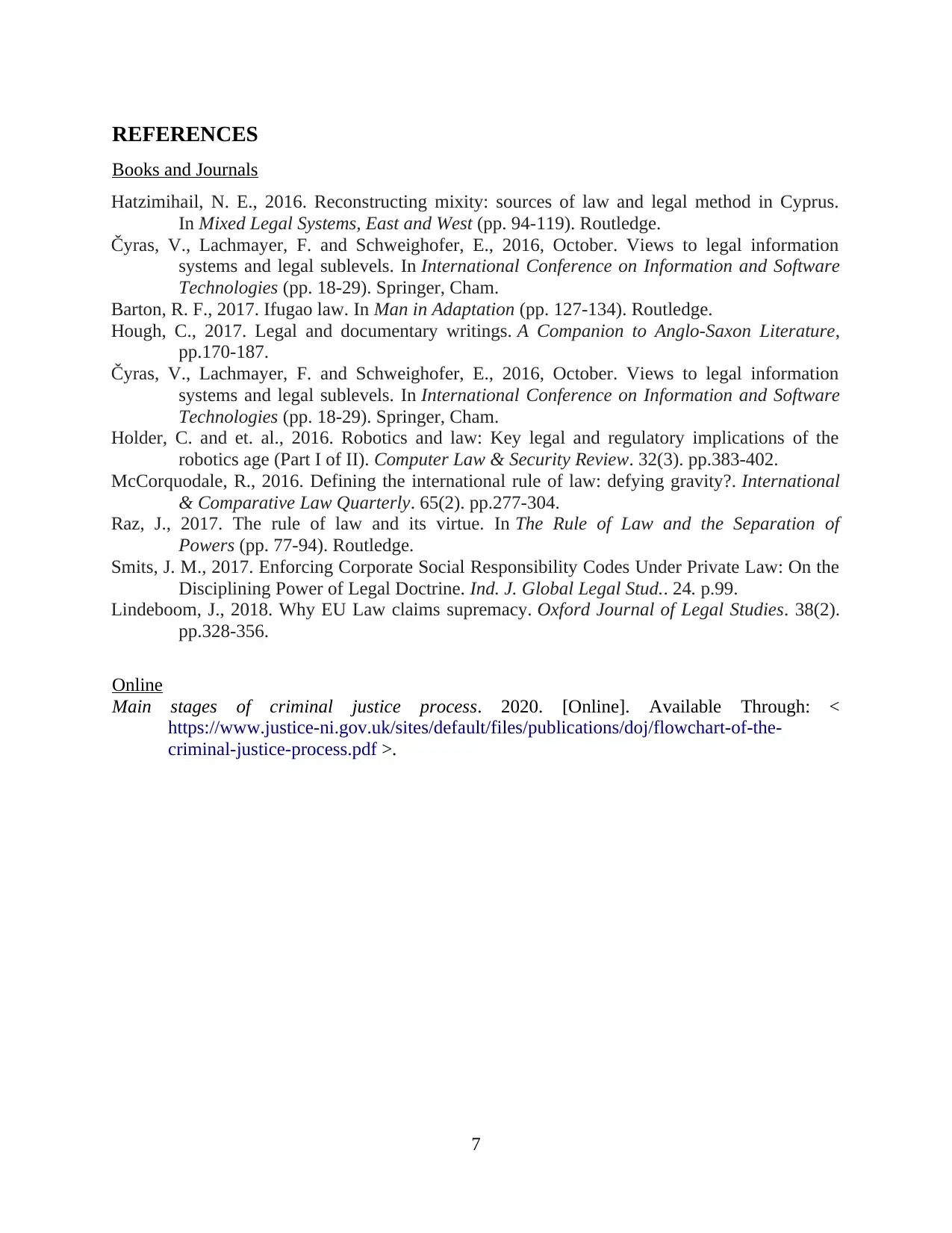
REFERENCES
Books and Journals
Hatzimihail, N. E., 2016. Reconstructing mixity: sources of law and legal method in Cyprus.
In Mixed Legal Systems, East and West (pp. 94-119). Routledge.
Čyras, V., Lachmayer, F. and Schweighofer, E., 2016, October. Views to legal information
systems and legal sublevels. In International Conference on Information and Software
Technologies (pp. 18-29). Springer, Cham.
Barton, R. F., 2017. Ifugao law. In Man in Adaptation (pp. 127-134). Routledge.
Hough, C., 2017. Legal and documentary writings. A Companion to Anglo‐Saxon Literature,
pp.170-187.
Čyras, V., Lachmayer, F. and Schweighofer, E., 2016, October. Views to legal information
systems and legal sublevels. In International Conference on Information and Software
Technologies (pp. 18-29). Springer, Cham.
Holder, C. and et. al., 2016. Robotics and law: Key legal and regulatory implications of the
robotics age (Part I of II). Computer Law & Security Review. 32(3). pp.383-402.
McCorquodale, R., 2016. Defining the international rule of law: defying gravity?. International
& Comparative Law Quarterly. 65(2). pp.277-304.
Raz, J., 2017. The rule of law and its virtue. In The Rule of Law and the Separation of
Powers (pp. 77-94). Routledge.
Smits, J. M., 2017. Enforcing Corporate Social Responsibility Codes Under Private Law: On the
Disciplining Power of Legal Doctrine. Ind. J. Global Legal Stud.. 24. p.99.
Lindeboom, J., 2018. Why EU Law claims supremacy. Oxford Journal of Legal Studies. 38(2).
pp.328-356.
Online
Main stages of criminal justice process. 2020. [Online]. Available Through: <
https://www.justice-ni.gov.uk/sites/default/files/publications/doj/flowchart-of-the-
criminal-justice-process.pdf >.
7
Books and Journals
Hatzimihail, N. E., 2016. Reconstructing mixity: sources of law and legal method in Cyprus.
In Mixed Legal Systems, East and West (pp. 94-119). Routledge.
Čyras, V., Lachmayer, F. and Schweighofer, E., 2016, October. Views to legal information
systems and legal sublevels. In International Conference on Information and Software
Technologies (pp. 18-29). Springer, Cham.
Barton, R. F., 2017. Ifugao law. In Man in Adaptation (pp. 127-134). Routledge.
Hough, C., 2017. Legal and documentary writings. A Companion to Anglo‐Saxon Literature,
pp.170-187.
Čyras, V., Lachmayer, F. and Schweighofer, E., 2016, October. Views to legal information
systems and legal sublevels. In International Conference on Information and Software
Technologies (pp. 18-29). Springer, Cham.
Holder, C. and et. al., 2016. Robotics and law: Key legal and regulatory implications of the
robotics age (Part I of II). Computer Law & Security Review. 32(3). pp.383-402.
McCorquodale, R., 2016. Defining the international rule of law: defying gravity?. International
& Comparative Law Quarterly. 65(2). pp.277-304.
Raz, J., 2017. The rule of law and its virtue. In The Rule of Law and the Separation of
Powers (pp. 77-94). Routledge.
Smits, J. M., 2017. Enforcing Corporate Social Responsibility Codes Under Private Law: On the
Disciplining Power of Legal Doctrine. Ind. J. Global Legal Stud.. 24. p.99.
Lindeboom, J., 2018. Why EU Law claims supremacy. Oxford Journal of Legal Studies. 38(2).
pp.328-356.
Online
Main stages of criminal justice process. 2020. [Online]. Available Through: <
https://www.justice-ni.gov.uk/sites/default/files/publications/doj/flowchart-of-the-
criminal-justice-process.pdf >.
7
1 out of 10
Related Documents
Your All-in-One AI-Powered Toolkit for Academic Success.
+13062052269
info@desklib.com
Available 24*7 on WhatsApp / Email
![[object Object]](/_next/static/media/star-bottom.7253800d.svg)
Unlock your academic potential
Copyright © 2020–2025 A2Z Services. All Rights Reserved. Developed and managed by ZUCOL.





